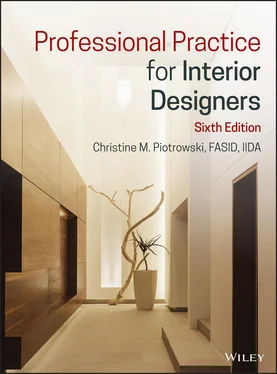Christine M. Piotrowski - Professional Practice for Interior Designers
Здесь есть возможность читать онлайн «Christine M. Piotrowski - Professional Practice for Interior Designers» — ознакомительный отрывок электронной книги совершенно бесплатно, а после прочтения отрывка купить полную версию. В некоторых случаях можно слушать аудио, скачать через торрент в формате fb2 и присутствует краткое содержание. Жанр: unrecognised, на английском языке. Описание произведения, (предисловие) а так же отзывы посетителей доступны на портале библиотеки ЛибКат.
- Название:Professional Practice for Interior Designers
- Автор:
- Жанр:
- Год:неизвестен
- ISBN:нет данных
- Рейтинг книги:4 / 5. Голосов: 1
-
Избранное:Добавить в избранное
- Отзывы:
-
Ваша оценка:
- 80
- 1
- 2
- 3
- 4
- 5
Professional Practice for Interior Designers: краткое содержание, описание и аннотация
Предлагаем к чтению аннотацию, описание, краткое содержание или предисловие (зависит от того, что написал сам автор книги «Professional Practice for Interior Designers»). Если вы не нашли необходимую информацию о книге — напишите в комментариях, мы постараемся отыскать её.
Professional Practice for Interior Designers
Professional Practice for Interior Designers — читать онлайн ознакомительный отрывок
Ниже представлен текст книги, разбитый по страницам. Система сохранения места последней прочитанной страницы, позволяет с удобством читать онлайн бесплатно книгу «Professional Practice for Interior Designers», без необходимости каждый раз заново искать на чём Вы остановились. Поставьте закладку, и сможете в любой момент перейти на страницу, на которой закончили чтение.
Интервал:
Закладка:
Discuss how the interior design profession protects the health, life safety, and welfare (HSW) of clients and the general public.
Explain why it is important for the Council for Interior Design Qualification (CIDQ) to be an independent organization.
Explain why you believe (or don't believe) the National Council for Interior Design Qualification (NCIDQ) examination is important to the profession and a professional.
Investigate the membership requirements of one (or more) of the professional associations paying special attention to student membership.
Compare a practice act to a title act regarding a practitioner's qualifications and impact on the public.
Discuss the pros and cons of affiliating with a design professional association.
NCIDQ COMPONENT
Based on the best information available, some material in this chapter might appear as part of the NCIDQ examination. The reader should not depend solely on this text for study material. See the sections on licensing and registration.
EDUCATIONAL PREPARATION
Regardless of whether someone wishes to design residences or become involved in designing any type of commercial interior space, strong educational preparation should be considered mandatory. Owners and users of interior spaces who hire professional help expect the interior designer to have the knowledge and skills to perform the required work with more in mind than aesthetics.
To encompass the range of knowledge and skills development required today, interior design programs are interdisciplinary, drawing from the arts, architecture, and human ecology. It is also important for students to have coursework in business and the liberal arts. Depending on the location of the program and the educational institution, the professional and technical coursework will have a slightly different focus.
The Council for Interior Design Accreditation (CIDA), with assistance from the Council on Interior Design Qualification (CIDQ) and the Interior Design Educators Council (IDEC), and funding from the key professional organizations, has helped to research the common body of knowledge and skills needed by competent professional interior designers. The complete listing of the elements of this body of knowledge is available at the Web site www.idec.org.
Whether a two‐year program at a community college, a three‐ to four‐year program at a professional school or university, or a “two plus two” program where a student begins at a community college and finishes a bachelor's degree at a university, in‐depth educational preparation is imperative. In some cases, advanced education is important for an individual's career choice. Teaching requires educational preparation beyond the bachelor's degree. Some specialized areas such as lighting design also benefit from advanced education.
Regardless of the level of degree sought, professional educational training in interior design must provide the student with the theory and skills of the profession, as well as with the general education required in the 21st century. The focus of that training must also meet the student's interests, abilities, and career goals.
Advanced Education
Many designers seek postgraduate education in interior design, architecture, and business, to name just a few broad areas. Sometimes designers obtain additional education in order to increase their technical skills and to allow themselves an opportunity to advance within the firm in which they work. Sometimes they seek additional education in order to retrain for a new area of expertise, such as lighting design, or to move into management.
Design professionals who seek an advanced degree most often obtain a master's degree. A master's degree involves advanced studies or research work. Master's‐degree work commonly requires a minimum of 30 semester credit hours, with actual degree requirements being prescribed by the institution. A graduate student's work culminates in a graphic or written thesis, depending on his or her academic focus and the requirements of the institution.
Individuals who are particularly interested in teaching at the college level or are interested in research topics may choose to obtain a doctorate rather than a master's degree. Doctoral studies are more extensive than master's, with additional numbers of credit hours and research requirements. Research studies conclude with the production of a doctoral dissertation that presents research conclusions.
Curriculum Accreditation
The 20th century saw many changes in design education. As the century progressed, a number of formal college course and programs in interior decoration became available across the country. The profession became more formalized and began to change its image from that of the untrained decorator to that of the trained professional.
Yet, these new educational programs caused concerns about educational requirements and programs that evolved during the 1940s and 1950s. The professional organizations supported the creation of an accrediting agency to help standardize interior design education. In 1970, the Foundation for Interior Design Education Research (FIDER) was founded to provide voluntary accreditation. This organization had great success in accrediting programs across North America. In 2006, the FIDER board voted to rename the organization the Council for Interior Design Accreditation (CIDA). This nonprofit organization, recognized by the Council on Higher Education Accreditation (CHEA), is considered the reliable authority on the quality of postsecondary interior design education in North America. Accreditation of a program indicates to the student that the curriculum meets educational standards that are accepted and supported by the profession of interior design.
The CIDA “has been passionately committed to the ongoing enrichment of the interior design profession through identifying, developing and promoting quality standards for the education of entry‐level interior designers.” * The council continues to develop and evaluate educational standards in interior design programs as a means of granting accreditation. These standards are reviewed from time to time, and the full details of the updated standards are available on the Web site, www.accredit‐id.org/resources.
CIDA accredits a single type of program of interior design education, the professional‐level program. The program must result in a minimum of a bachelor's degree and must include classes in the arts and sciences, as well as courses specific to interior design and other specific standards detailed in the Professional Standards document available from CIDA. Other types of programs including Master's degrees and online programs may meet CIDA standards. Information on these kinds of topics should be researched from the CIDA Web site for the most current standards. This would include programs outside the United States.
Accreditation of an interior design program is a voluntary process of self‐study and measurement of the curriculum against the CIDA standards. This self‐study investigates the quality of programs as meeting the needs of professionals in the current market. After the self‐study, a group of site visitors conducts reviews of materials and discussions with faculty, students, and administrators. Accreditation is not forever; a program must be reevaluated every six years.
*Council for Interior Design Accreditation, 2006, Accreditation Manual , p. 1–1.
INTERNSHIPS
A very important part of educational preparation in interior design is an internship. An internship is a supervised work experience within an interior design firm or other appropriate company within the industry. Internships are generally a part of the required curriculum. It is an intensive work experience providing students the opportunity to work in the real world before starting a full‐time job and see how coursework relates to the professional world. In addition, internships give students some work experience that they can include on their resumés.
Читать дальшеИнтервал:
Закладка:
Похожие книги на «Professional Practice for Interior Designers»
Представляем Вашему вниманию похожие книги на «Professional Practice for Interior Designers» списком для выбора. Мы отобрали схожую по названию и смыслу литературу в надежде предоставить читателям больше вариантов отыскать новые, интересные, ещё непрочитанные произведения.
Обсуждение, отзывы о книге «Professional Practice for Interior Designers» и просто собственные мнения читателей. Оставьте ваши комментарии, напишите, что Вы думаете о произведении, его смысле или главных героях. Укажите что конкретно понравилось, а что нет, и почему Вы так считаете.












